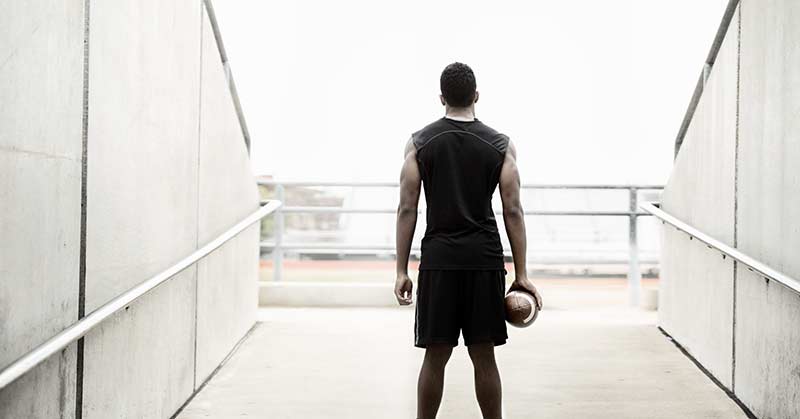[mashshare]

It puzzles me that we spend so much time in the off-season training for qualities that we feel will make our athletes more successful on the field, but once the season hits, it all kind of goes to hell in a handbasket. In fact, I see some coaches who use the weight room as a babysitter for their athletes. They have an hour to kill for practice to be the “appropriate” amount of time, so they send their athletes into the weight room, where they do their “Friday Night” workouts, pumping up their arms and doing some benchwork because they like to. For the most part, it looks like a late afternoon at Lifetime Fitness: a lot of people standing around, talking, posing, and finding a way to do as little as possible.
I want to strip back the in-season routine and see if we can’t find a better solution. This way, we can have continual progress toward the goal of developing better athletes without losing any time. There can be continual improvement if we look at the big picture. This can be really beneficial for younger athletes who need more development, as well as two-sport athletes who want to change from one sport to the other without missing a step. I will look at the situation from a football/track standpoint. The ideal goal is to use in-season football to help track athletes, and use in-season track to help football. Even though I am a track coach, I must admit that track coaches need to give in a little to “Friday Night Lights.”
We need to look at Friday night games from an exercise perspective. Share on XWe need to look at Friday night games from an exercise perspective. I would say that it is certainly a maximum effort exercise that taxes the body to the limit in almost all areas. In playing the game, there are 40-50 reps on acceleration work, with agility added into the mix. There is also unstable upper body work, which includes isometric work in locking out, concentric work in blocking, and eccentric work in falling. Overall, it is a whole-body workout that takes the athlete to their physical limit. How can we get our athletes to recover and get better at the same time? And what can we do during in-season football training to help develop the track athlete without hindering the athlete from being their best on Friday night?
The Week After: A Training Schedule Leading Up to Friday Night
On the day after the game, long-duration isometrics (30 seconds) can be beneficial. First, isometric strength is a foundation for all reflexive movements. Isometric strength can certainly help any kind of explosive movement, including sprinting and jumping, and isometric strength does not create a lot of muscle soreness once the athlete is used to the load. It also creates a lot of blood flow when the hold is for a longer time, like 30 seconds, which will greatly aid in recovery and move toxins that build up from the recovery process while sleeping after the game. (Have you ever seen a cooldown after a football game? Even better, have you ever seen what a high school football player eats after a game?)
To really get blood flowing, pick a lighter weight, hold it for 30 seconds, do three reps and repeat. Try to go for two minutes of ISO holds in a mid-point position. The exercises I like are the split squat, jack-knife split squat, glute ham plank, bench, and row. Do the longer duration work with the upper body, and with the lower body, keep it to two sets of 30 with 45 seconds of rest.
More growth hormone is released with the shorter rest period. The 45-second rest gives partners time to change over as well. And with controlled workouts, you can keep the time in the weight room to a minimum. Also have athletes keep track of their weight. You want a gradual increase every week. If an athlete is struggling, it will excuse him or her from the rest of the workouts for the week.
Sunday should be complete rest.
Most coaches use Monday as a walk-through. We also use it as a day of rest and recovery. Dan Fichter calls it tactical training. Build your workouts around what is going on in the field. It only taxes the body more, or creates less recovery time, if you have a walk- through day on the field and a taxing day in the weight room.
This leads us to Tuesday, which is a hard day in most football practices. Packages and plays have been taught and now it is time to see how they work. You want to take advantage of this day and make it a hard day in the weight room. Tuesdays will be your concentric day, where you work the force-velocity curve on major movements. However, before you get into the weight room, it would be smart to create a power baseline with a vertical jump. Have an athlete complete three separate jumps. If their best is more than 10% below the previous week, they are not ready to work out.
Once in the weight room, you can get some force work to help into the track season for starts. (I know this is a crazy idea, actually doing track stuff during football season—borderline blasphemy!) For the sprinters/skill players, I like the two-step sled push. After two to three weeks of pushing the sled, attach the athlete to a rubber band from their start and pull them out of their stance, almost like an overspeed start. This will deal with the velocity aspect of the force-velocity curve.
If the head coach questions it, any concentric movement off a pin would be great. A quarter squat off a pin would be great. A deadlift off a pin. Bench off a pin. These would all be for singles with no eccentric portion to the lift. Push it up and put it on the rack. Spotters can put it back down. Save the eccentric work for the field and Friday Night Lights. And, as with the shove, attach bands from above and do some French contrast jumps with the bands. It will be a great change-up for the body.
Wednesday is usually another hard day, so you can use that to your advantage and get one more workout in that could help. Skip upper on this day and rest up for Friday. But touch into the neural world of top-end speed. Research on NFL teams using the latest technology shows that most players never go more than 80% of their speed. So, they don’t train there. But if most of what they do is acceleration and they stop before the point of max velocity, it doesn’t mean that they are not neurally getting to max speed.
After watching a lot of football on many different levels, especially high school, I think this is the reason many teams slow down by the second half of the season. They have gassered away all of their explosion and top end speed. They become really good at 40-yard repeats in an exhausted mode, which is slow. To solve this problem, bring out the lasers for some fly 10s to start practice. In fact, warm up with some deep fade routes and time the player’s fly 10 during the route before he catches the ball. I think two to three would be sufficient. You just want to remind the brain that the gear is still there. Again, if they are coming out slow, it might be a good idea to hold that player back in practice to get them ready for Friday night.
The cat is probably out of the bag at this point: I am using in-season football training to get ready for track season. But, I think it is only fair that a good number of athletes use track to “get ready” for football. From a track coach’s perspective, it can be useful to develop some work in the “pre-season,” so you can spend more time running during the season.
Here is what the week will look like:
Friday: Game
Saturday: Isometric work
Sunday: Rest
Monday: Light practice
Tuesday: Force/concentric work
Wednesday: Fly 10s
Thursday: Light practice
For teams that play through the summer, like we do in Illinois, apply the same principles. Almost every day is a max day, so adjust the workouts accordingly. I see too many people go too hard in the weight room in the summer and it results in athletes on crutches or braces for the first game.
We need to account for the two-sport athlete, the working athlete, and the partying athlete in the summer months. Some can’t and others won’t make the sacrifice to give up the good times of summer. We need to meet them halfway.
Remember, the goal of the summer is to go to camp with your whole team intact. The goal of camp is to field your best 22 on opening night. It is a war of attrition.
Since you’re here…
…we have a small favor to ask. More people are reading SimpliFaster than ever, and each week we bring you compelling content from coaches, sport scientists, and physiotherapists who are devoted to building better athletes. Please take a moment to share the articles on social media, engage the authors with questions and comments below, and link to articles when appropriate if you have a blog or participate on forums of related topics. — SF
[mashshare]





